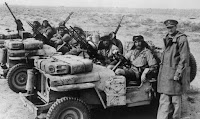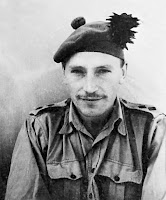November 15, 1915 - Lecropt, Perthshire, Scotland - Archibald David Stirling is born
July 24, 1937 - Ampleforth, North Yorkshire - Commissioned into the Scots Guards
June 23, 1940 - Burnham on Crouch, Essex - Volunteers for the new No.8 Commando under Lt.Col Robert Laycock =(START)
October 24, 1940 - Lamlach, Isle of Arran, West Scotland - 8 (Guards) Commando, moves to the Isle of Arran
January 31, 1941 - Isle of Arran - Firth of Clyde - 11 (Scottish) Commando departs from the Firth of Clyde aboard 3 infantry landing ships "Glengyle", "Glenroy" and "Glenearn", together with 7 Commando and 8 (guards) commando
February 11, 1941 - Freetown, Sierra Leone - The ships stop at Freetown
February 13, 1941 - Line of the Equator - Force Z crosses the Equator
February 19, 1941 - Cape Town, South Africa - The ships stop at Cape Town.
February 28, 1941 - Line of the Equator - Force Z crosses the Equator
March 7, 1941 - Geneifa, Egypt - Sailed into the Suez Canal
April 12, 1941 - Alexandria, Egypt - Layforce sets off for Alexandria
April 15, 1941 - Bombah, between Derna and Tobruk, Libya - Arrives off Bombah in a destroyer. The operation is called off because of the swell
May 26, 1941 - Souda Bay, Crete - Stirling lands from HMS Abdiel. Starts moving south to Sphakia
May 31, 1941 - Sphakia - The Commandos withraw to Sphakia (Stirling wounded?)
June 2(?), 1941 - Alexandria - The survivors reach Egypt
July 1, 1941 - Al Kibrit (Kabrit), N. of Suez - Training Camp at RAF Kabrit, north of Suez
July 17, 1941 - Tobruk Area - Raid on an italian position (Stirling wounded?)
July 30(?), 1941 - Alexandria - David Stirling is released from Alexandria Scottish Military Hospital
August 30(?), 1941 - Al Kibrit (Kabrit), N. of Suez - David Stirling establishes his new force, The "Special Air Service" (SAS), at the RAF Kabrit facilities, north of Suez. "Paddy" Mayne is Stirling's first choice
November 16, 1941 - Gazala | Tamini Airfields - Parachute drop in Lybia - Gazala + Tamini Airfields (mission fails as during the drop in poor weather, vital supplies and detonators were lost) - the group begins a 40 mile walk into the desert for a rendezvous with a motor patrol for the Long Range Desert Group
November 19, 1941 - 23 of the original 51 who parachuted arrive at the rendezvous point
 |
| Stirling (right), welcomes a patrol just arrived from mission |
December 8, 1941 - Jalo Oasis - Stirling and Mayne depart from Jalo with the LRDG to attack Tamet And Sirte airfields
December 14, 1941 - Sirte - Stirling drops off at Sirte, only to find the airfield being evacuated
December 21, 1941 - Jalo Oasis - Stirling and Mayne depart for a second raid to Tamet Airfield
December 27, 1941 - Bagush - Stirling raids Bagush airfield - unable to plant their bombs, they improvize with a motorized charge down the airstrip, blazing away at the aircraft with machine guns and grenades
January 3, 1942 - Jalo Oasis - LRDG picks up Stirling and Mayne on December 28th and takes them to base
January 17(?), 1942 - Jalo Oasis - Stirling and Mayne return to Kabrit to plan the next action and train new SAS volunteers
January 23, 1942 - Buerat, W. of Sirte, Libya - Buerat Raid - Although the harbor had been empty of shipping, the raid resulted in the destruction of 18 petrol bowsers and 4 food dumps
January 30(?), 1942 - Al Kibrit (Kabrit), N. of Suez - Promoted to Major
March 15, 1942 - Siwa (SAS Base) - Stirling and Mayne depart for Berka
March 21(?), 1942 - Benina Airfield - 5 aircraft destroyed + 30 new aircraft engines and 3 hangars full of machinery destroyed
April 5, 1942 - Hagfet Gelgaf - in the Jebel Akhdar, a heavily forested, fertile upland area in northeastern Libya
May 9, 1942 - Jebel Akhdar - Raid
July 1, 1942 - Fuka | Mersa Matruh Airfields - Raid
July 4, 1942 - Al Kibrit (Kabrit), N. of Suez - The SAS convoy moves off for the rendezvous north of the Quattara Depression
July 7, 1942 - Fuka Airfield - Raid to Fuka Airfield - The SAS bomb and shoot between 30 and 40 enemy aircraft
July 9, 1942 - El Daba Airfield (50 miles W of El Alamein) - 14 aircraft destroyed
July 11, 1942 - Fuka Airfield - 22 aircraft destroyed
July 15, 1942 - Al Kibrit (Kabrit), N. of Suez - Back at Kabrit for stores and new transports
July 19, 1942 - Fuka | Sidi Haneish area - Stirling and Mayne reach the rendezvous point
July 27, 1942 - Sidi Haneish Airfield - Raid with 18 jeeps and 68 vickers machineguns - 40 aircraft destroyed
August 3(?), 1942 - Kabrit | Cairo - Back in Cairo Area
September 7, 1942 - Kufra, SE Libya - Stirling arrives at the Forward Operating Base, before attacking Djebel
September 23, 1942 - Kabrit | Cairo - Stirling starts recruiting fresh troops from Britain and whip them through an intensive training course
January(?) 5(?), 1943 - Between "Paddy" and Tripoli - Stirling's "B Squadron" engages in raiding operations for a week
January 14, 1943 - Gabès Gap Area, Tunisia - Stirling is Captured by a german recce unit in a Wadi en Route to raid Sousse
April(?) 1(?), 1943 - Gavi, Italy - Stirling tries to escape from Gavi no less than 4 times
January 1(?), 1944 - Marisch Trubau - Stirling is taken to Marisch Trubau, 6 miles from Czechoslovakia
August 20, 1944 - Colditz Castle, Germany - Stirling is taken to Colditz Castle, near Leipzig
April 16, 1945 - Colditz Castle - The Americans enter in Colditz and liberate the POWs in the castle
October 1, 1945 - Chelmsford, Essex - Formal disbandment of the Special Air Service
January(?) 1(?), 1946 - Salisbury, Southern Rhodesia - Stirling moves to Southern Rhodesia
January(?) 1(?), 1949 - Salisbury - Stirling founds the Capricorn Africa Society
May 1(?), 1974 - Britain - David Stirling starts sounding out friends and comrades about a new organization he called GB75
April 1(?), 1975 - Britain - GB75 disintegrates and Stirling announces that he would pour his energies into an anti-communist lobby
June 1, 1984 - Hereford - Opening of the new Barracks (Stirling Lines). Stirling speaks to the visitors
November 4, 1990 - Westminster, London - Archibald David Stirling dies, aged 84 =(END)
March 15, 1942 - Siwa (SAS Base) - Stirling and Mayne depart for Berka
March 21(?), 1942 - Benina Airfield - 5 aircraft destroyed + 30 new aircraft engines and 3 hangars full of machinery destroyed
April 5, 1942 - Hagfet Gelgaf - in the Jebel Akhdar, a heavily forested, fertile upland area in northeastern Libya
May 9, 1942 - Jebel Akhdar - Raid
July 1, 1942 - Fuka | Mersa Matruh Airfields - Raid
July 4, 1942 - Al Kibrit (Kabrit), N. of Suez - The SAS convoy moves off for the rendezvous north of the Quattara Depression
July 7, 1942 - Fuka Airfield - Raid to Fuka Airfield - The SAS bomb and shoot between 30 and 40 enemy aircraft
July 9, 1942 - El Daba Airfield (50 miles W of El Alamein) - 14 aircraft destroyed
July 11, 1942 - Fuka Airfield - 22 aircraft destroyed
July 15, 1942 - Al Kibrit (Kabrit), N. of Suez - Back at Kabrit for stores and new transports
July 19, 1942 - Fuka | Sidi Haneish area - Stirling and Mayne reach the rendezvous point
July 27, 1942 - Sidi Haneish Airfield - Raid with 18 jeeps and 68 vickers machineguns - 40 aircraft destroyed
August 3(?), 1942 - Kabrit | Cairo - Back in Cairo Area
September 7, 1942 - Kufra, SE Libya - Stirling arrives at the Forward Operating Base, before attacking Djebel
September 23, 1942 - Kabrit | Cairo - Stirling starts recruiting fresh troops from Britain and whip them through an intensive training course
January(?) 5(?), 1943 - Between "Paddy" and Tripoli - Stirling's "B Squadron" engages in raiding operations for a week
January 14, 1943 - Gabès Gap Area, Tunisia - Stirling is Captured by a german recce unit in a Wadi en Route to raid Sousse
April(?) 1(?), 1943 - Gavi, Italy - Stirling tries to escape from Gavi no less than 4 times
January 1(?), 1944 - Marisch Trubau - Stirling is taken to Marisch Trubau, 6 miles from Czechoslovakia
August 20, 1944 - Colditz Castle, Germany - Stirling is taken to Colditz Castle, near Leipzig
April 16, 1945 - Colditz Castle - The Americans enter in Colditz and liberate the POWs in the castle
October 1, 1945 - Chelmsford, Essex - Formal disbandment of the Special Air Service
January(?) 1(?), 1946 - Salisbury, Southern Rhodesia - Stirling moves to Southern Rhodesia
January(?) 1(?), 1949 - Salisbury - Stirling founds the Capricorn Africa Society
May 1(?), 1974 - Britain - David Stirling starts sounding out friends and comrades about a new organization he called GB75
April 1(?), 1975 - Britain - GB75 disintegrates and Stirling announces that he would pour his energies into an anti-communist lobby
June 1, 1984 - Hereford - Opening of the new Barracks (Stirling Lines). Stirling speaks to the visitors
November 4, 1990 - Westminster, London - Archibald David Stirling dies, aged 84 =(END)












